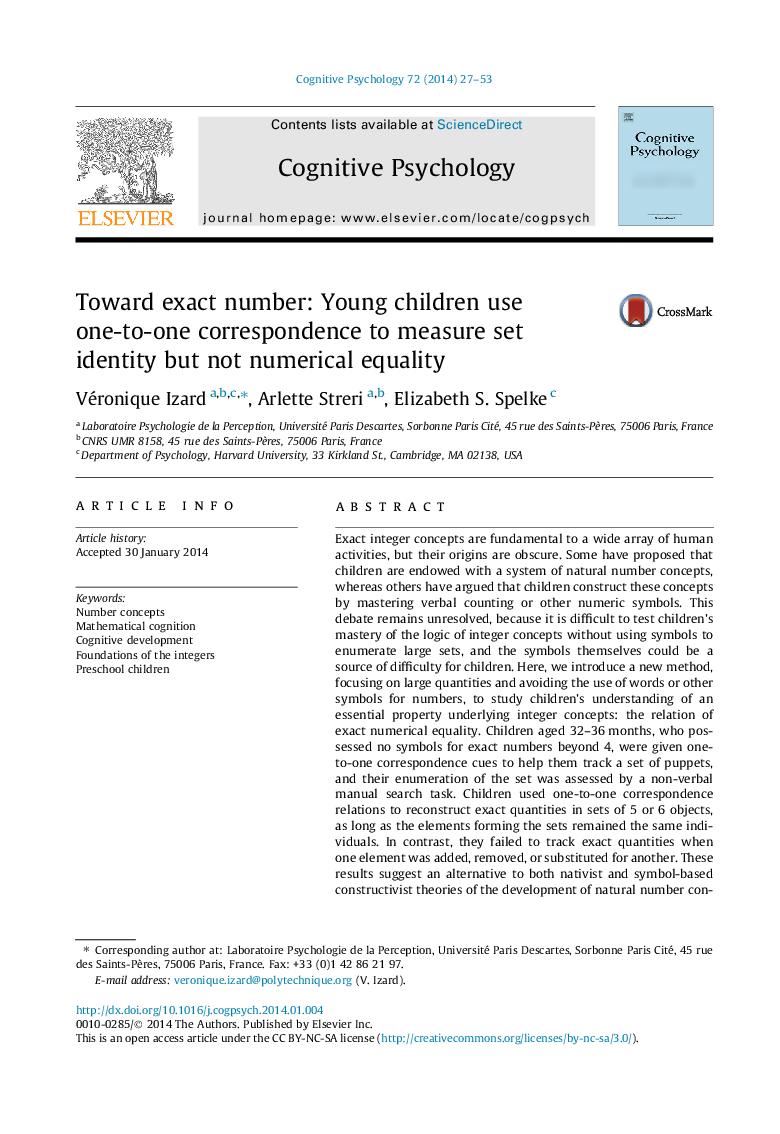| کد مقاله | کد نشریه | سال انتشار | مقاله انگلیسی | نسخه تمام متن |
|---|---|---|---|---|
| 7272796 | 1473392 | 2014 | 27 صفحه PDF | دانلود رایگان |
عنوان انگلیسی مقاله ISI
Toward exact number: Young children use one-to-one correspondence to measure set identity but not numerical equality
ترجمه فارسی عنوان
به تعداد دقیق: بچه های کوچک از مکالمه یک به یک برای اندازه گیری هویت مجموعه، اما برابری عددی استفاده نمی کنند
دانلود مقاله + سفارش ترجمه
دانلود مقاله ISI انگلیسی
رایگان برای ایرانیان
کلمات کلیدی
مفاهیم تعداد، شناخت ریاضی، توسعه شناختی، مبانی عدد صحیح، کودکان پیش دبستانی،
ترجمه چکیده
مفاهیم دقیق عدد صحیح برای یک مجموعه گسترده ای از فعالیت های انسانی اساسی هستند، اما ریشه های آنها مبهم است. برخی پیشنهاد کرده اند که کودکان با یک سیستم از مفاهیم تعداد طبیعی برخوردار هستند، در حالی که دیگران استدلال کرده اند که بچه ها این مفاهیم را با تسلط بر شمارش کلامی و یا سایر نمادهای عددی ایجاد می کنند. این بحث هنوز حل نشده است، زیرا آزمایش تدریجی کودکان از منطق مفاهیم عدد صحیح بدون استفاده از نمادها برای شمارش مجموعه های بزرگ مشکل است و نمادها می توانند منبع مشکل برای کودکان باشند. در اینجا روش جدیدی را معرفی می کنیم که با تمرکز بر مقادیر زیاد و اجتناب از استفاده از کلمات یا سایر نمادها برای اعداد به بررسی درک کودکان از اموال اساسی مفاهیم عدد صحیح می پردازد: رابطه تساوی دقیق عددی. کودکان در سن 32 تا 36 سالگی، که ماههاست که هیچ علامتی برای تعداد دقیق بیش از 4 نفر نداشتند، دستورالعمل مکالمه یک به یک به آنها کمک کرد تا مجموعه ای از عروسک ها را ردیابی کنند، و شمارش آنها از طریق غیر کلامی وظیفه جستجو دستی کودکان از روابط مکالمه یک به یک برای بازسازی مقادیر دقیق در مجموعه های 5 یا 6 شیء استفاده می کنند تا زمانی که عناصر تشکیل دهنده مجموعه ها یکسان باقی مانده باشند. در مقابل، آنها هنگامی که یک عنصر اضافه، حذف شده یا جایگزین دیگری شدند، موفق به ردگیری مقدار دقیق نشدند. این نتایج نشان می دهد که جایگزینی برای نظریه های سازنده گرا از نظر ساختارگرایی مبتنی بر نماد توسعه ی مفاهیم تعداد طبیعی است: قبل از یادگیری نمادها برای تعداد دقیق، کودکان درک جزئی از خواص عدد دقیق دارند.
موضوعات مرتبط
علوم زیستی و بیوفناوری
علم عصب شناسی
علوم اعصاب شناختی
چکیده انگلیسی
Exact integer concepts are fundamental to a wide array of human activities, but their origins are obscure. Some have proposed that children are endowed with a system of natural number concepts, whereas others have argued that children construct these concepts by mastering verbal counting or other numeric symbols. This debate remains unresolved, because it is difficult to test children's mastery of the logic of integer concepts without using symbols to enumerate large sets, and the symbols themselves could be a source of difficulty for children. Here, we introduce a new method, focusing on large quantities and avoiding the use of words or other symbols for numbers, to study children's understanding of an essential property underlying integer concepts: the relation of exact numerical equality. Children aged 32-36Â months, who possessed no symbols for exact numbers beyond 4, were given one-to-one correspondence cues to help them track a set of puppets, and their enumeration of the set was assessed by a non-verbal manual search task. Children used one-to-one correspondence relations to reconstruct exact quantities in sets of 5 or 6 objects, as long as the elements forming the sets remained the same individuals. In contrast, they failed to track exact quantities when one element was added, removed, or substituted for another. These results suggest an alternative to both nativist and symbol-based constructivist theories of the development of natural number concepts: Before learning symbols for exact numbers, children have a partial understanding of the properties of exact numbers.
ناشر
Database: Elsevier - ScienceDirect (ساینس دایرکت)
Journal: Cognitive Psychology - Volume 72, July 2014, Pages 27-53
Journal: Cognitive Psychology - Volume 72, July 2014, Pages 27-53
نویسندگان
Véronique Izard, Arlette Streri, Elizabeth S. Spelke,
